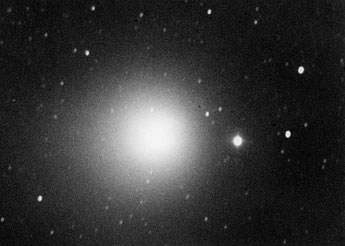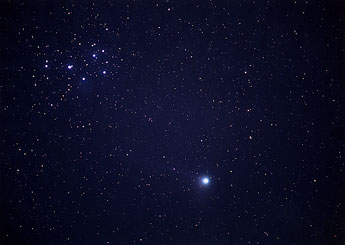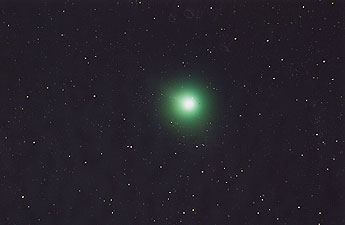• January 16
Comet Machholz has faded to about 4.5 magnitude, but the
coma is bright and clearly visible to the naked eye.

C/2004 Q2 (Machholz)
2-minute exposure from 01:48 on January 16, 2005
Geisei Observatory 60cm f/3.5 reflector
• January 7
The 21cm Epsilon f/3.0 telescope captured Machholz moving
north near the Pleiades. This photograph was taken by an 8-minute exposure
from 19:00 (J.S.T.) on January 7. Type 1 tail is faint but emits blue light
similar to the glow of the Pleiades.

C/2004 Q2 (Machholz)
8-minute exposure from 19:00 on January 7, 2005
ε210, Provia 400 film (6X7 format)
Good weather has prevailed over the year-end and New Year
period and I have been making good progress with my observation.
For observation of Comet Machholz Geisei's main telescope 60cm reflector
as well as 21cm and 16cm Epsilon telescopes have been effectively deployed.
In the 60cm scope the large greenish coma was impressive (photograph 1),
though its short tail looked no more than a short fuse for an explosive.
However, long exposures by the small f-ratios of Epsilon telescopes make
two magnificent tails visible (photograph 2) . The blue ion tail in the
opposite direction from the sun makes a striking contrast with a reddish
dust tail which looked pushing forward against the sun's force. Overall,
this comet has very faint tails.
The comet was at 3.2 magnitude and bright on January 2nd,
but binoculars may be better as its coma is relatively small.
The starry sky on the night of January 1st as seen from my
home at Kamimachi was breathtaking and the comet was easily visible to
the naked eye. Yes, this site is where I discovered six comets including
1961f (Comet Seki). On the first day of the new year the stunningly beautiful
starry skies of those days were recreated.
Many of the new year's greeting cards I received incorporated
images of Comet Machholz or local landscapes, a source of pride for the
senders. I found a very peculiar card among them. The sender was Mr. Mitsuyoshi
Kodama who works for Goto Optical Company. On the card there was a color
photograph of two of the volumes (Orbit Determination and Theory of Errors)
of Gauss's complete collection, which were published from the end of the
19th century to the early 20th century. Mr. Masamitsu Yamasaki, who had
studied in America for many years, gave me a book called "Manual of
Astronomy." The book was said to be written by Young, an American
astronomer. It was leather-bound and quite sturdy. Gauss's books are quite
similar to it in design. How did Mr. Kodama manage to get hold of such
rare and valuable books? I recall that he was a comet hunter when young
and wrote me frequently.
Gauss is well known for his unique orbital calculation of
Ceres, when this first minor planet was discovered from Sicily Island at
the beginning of the 1900s. His method of orbital calculations slightly
modified by Merton of the U.K. and others had been widely used for many
years until the introduction of personal computers. When I first started
orbital calculations around 1955, I was dumbfounded by running into Gauss's
quardratic equations totally unprepared, which was to work out an approximation
of the distance to an astronomical object in the course of determining
the orbit of a minor planet. There was no textbook available to help me
and I struggled to find solutions by myself and continued calculating.
Generally there are four solutions in a quardratic equation, but actually
only two appeared on a graph. I often got incorrect values and my calculated
orbits turned out to be incredibly wrong.
With the photograph of Gauss's theoretical books staring
at me, I vividly remember that I visited Mr. Ichiro Hasegawa (see the photograph
in the diary dated December 5, 2004) at Suma while I was engaged in orbit
calculations. It was time when you could calculate all by yourself the
orbit of the comet you had discovered. It was time when such an aspiration
was fulfilled.

Photograph 1: C/2004 Q2 (Machholz)
8-minute exposure from 20:50 on January 2, 2005
60cm reflector on ISO 800 film

Photograph 2: C/2004 Q2 (Machholz)
20-minute exposure from 20:12 on December 31, 2004
ε160 f/3.3 ISO 800 film

Photograph 3: Two volumes of Gauss's complete collection
Volume 7 Theory of Orbit Determination (1906) (upper)
Volume 4 Theory of Errors (1880)





